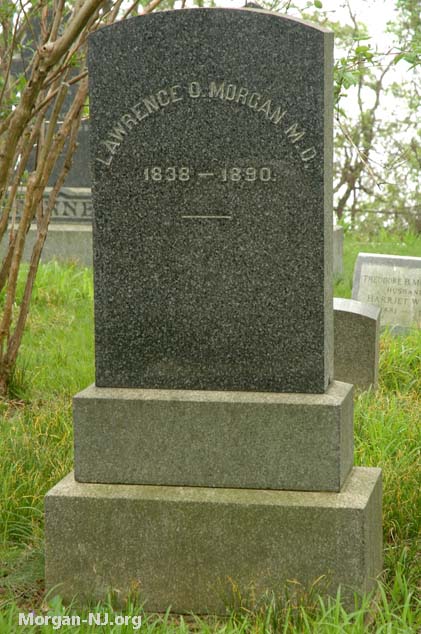
Morgan Memories – Dr. Morgan, I Presume?
This author lives in California but writes about a niche topic located some three thousand miles away. On those occasional times when I am able to get back to Morgan, I will almost always stop outside the gate of the Morgan Family Cemetery to see how it is doing. It was a big part of the childhood lives of those of us who grew up there before the fence was put up. It was the shortcut to get to Little Suey and the pathway on the side of the cliff to get to Big Suey (known to previous generations as “Forty Horses”). Big Suey and Little Suey were big cliffs overlooking Raritan Bay and the railroad tracks. The cemetery was also the starting point for some great sled riding. As a kid, I don’t think I thought much about the diverse array of gravestones we would walk past and between except to notice that some of them seemed to be pretty old and some were broken. The two tall ones marked “Tanner” stood out as did the little one next to them surrounded by the ancient metal gate.
On a trip in 2018, I stopped by the cemetery to look in and, as is usual and very welcomed by me, was challenged by a cemetery neighbor as to why I was hanging around the site. Fortunately – again – the neighbor was a reader of this web site so instead of being treated as someone looking to do something nefarious, I was again treated as a micro-celebrity author. Because of the various research done for this web site over the already 10+ years it has been in existence, I am now able to point to a number of the headstones and give a little story about the life of the people buried underneath them. To my challenger, I pointed to the stones over Captain James Morgan, Sr. and his wife Margaret Roetus Evertson Morgan, then pointed right next to the Captain to the final resting place of their son, Major General James Morgan, Jr. I was then able to point to a row of the General’s grandchildren and to the headstone of the person this is all about.
I remember always being struck by the sparse headstone of “Lawrence O Morgan, M.D.” He seemed to be the only doctor buried in the cemetery but mostly I would wonder what the “O” stood for. In the early years of this web site, a member of the Morgan Family told me that Lawrence O. Morgan was a doctor who had served in the Civil War. From this equally sparse information, I was able to do some research on Dr. Morgan and, I was surprised to find, actually came up with some information. It isn’t a lot thus far but it’s a start. Maybe someday, someone will be able to present additional information which can be added to this page.
Lawrence Osmar Morgan was born the third of five children of Charles and Elizabeth Blackwell Rockwell Morgan (James Rutus, Charles, Lawrence Osmar, Ann Elizabeth, and Theodore Blackwell). He would have been the fifth generation Morgan to have lived on the property originally acquired in 1710. His fraternal grandparents were Major General James Morgan, Jr. and James’ second wife, Ann J. Van Wickle. Most likely Lawrence would have been born in the Morgan Family homestead – believed recently by this author to have likely been on the site of the house owned by Dr. Robinson (namesake of Robinson Drive) and subsequently Mr. Henderson (a.k.a., “The Chicken Farmer”). I don’t think it was there anymore at this time, however!
At the time of Lawrence’s birth on July 20, 1838, the estate was composed of, “… a large tract of valuable farming land, valuable clay-banks, and valuable timber lands, in all over 600 acres, …” Because of these physical property assets, the family was well off enough to allow for, “The brothers and sister [to be] educated at Freehold, Princeton or in Brooklyn.”
When Lawrence was only 14, tragedy hit the family by the early death of Lawrence’s father, Charles, on September 1, 1852. This lead to Lawrence’s oldest brother, the then 19-year-old James Rutus Morgan (November 12, 1833 – August 26, 1898), assuming management of the family’s farm, clay mines and timber lands until, as the will states, “my son Charles Morgan arrives to the age of twenty-one years.” That specified date would have been in 1857 – some five years after the death of the father.
James Rutus Morgan had some, but little, time to learn all he needed to learn from his dying father in order to administer the family’s estate and manage their interests. To his credit, he stepped up to the task.
Many years later, in 1891, the decision regarding a significant lawsuit, known as the Morgan vs. Morgan lawsuit, was documented. It provides a little insight into the waning years of the Morgan Family 600-acre estate which ultimately was sold off at an auction in 1893.
Information provided within the document of the Morgan vs. Morgan lawsuit shows that Lawrence was mostly attending school at the time of his father’s death.
While it isn’t clear which children went to which schools, there is a record of Lawrence receiving a degree from Rutgers College in nearby New Brunswick, NJ as one of the 28 students of the class of 1861. Lawrence would have been 22.
Lawrence’s name also appears in the roster of Rutgers College’s Delta Chapter of the Zeta Psi Fraternity for 1861. Rutgers College’s Delta Chapter, which is still present on College Avenue in New Brunswick, is the third oldest Zeta Psi chapter, having been founded in 1848. The oldest is New York University in New York City founded in 1847 & the second oldest is Williams College in Williamstown, MA founded in 1848.
It isn’t clear as to why Lawrence’s name is not contained on the Rutgers University Kirkpatrick Chapel plaque, located on the Old Queens Campus in New Brunswick, which shows the names of Rutgers graduates and students who served in the Civil War. Perhaps this was due to his service being relatively short or perhaps it was due to inadequate records or access to records at the time the plaque was created?
The Morgan Family member also indicated they saw information in the early 2000s about Dr. Lawrence O. Morgan while visiting the Gettysburg National Military Park. They were in a Ranger area and saw the information in a Rolodex type of display. It indicated Dr. Morgan was a surgeon’s assistant then later on a surgeon. Hopefully, someone in this reading audience will also be able to find this information, take a photo of it, and send it to this web site so we can all see it. I’ve not been able to find this info on the internet but there is a lot of information which isn’t available on the internet.
Records show that Lawrence O. Morgan was commissioned as an Assistant Surgeon in the 2nd Regiment New Jersey Cavalry F&S (Field & Staff) on September 23, 1863, but that same record indicates he was “not mustered” (i.e., didn’t actually physically get with the regiment). He would have been 24 at this time. It isn’t clear whether the 1861 degree from Rutgers College was a medical degree – that isn’t stated in the Rutgers College information – so possibly he went to another school for the medical degree. Here again, which school this was – if there was one – isn’t clear yet.
Less than three months after being commissioned in the 2nd Regiment, the records show that Lawrence was commissioned in a different Field and Staff unit, that of the 3rd Cavalry Regiment New Jersey as an Assistant Surgeon on December 18, 1863. Twelve days later on December 30, 1863, records show he was “Mustered In” (i.e., the regiment assembled) at Fort Bayard which was located somewhere in Trenton.
Civil War – 3rd Regiment, New Jersey Cavalry – Battle Unit Details
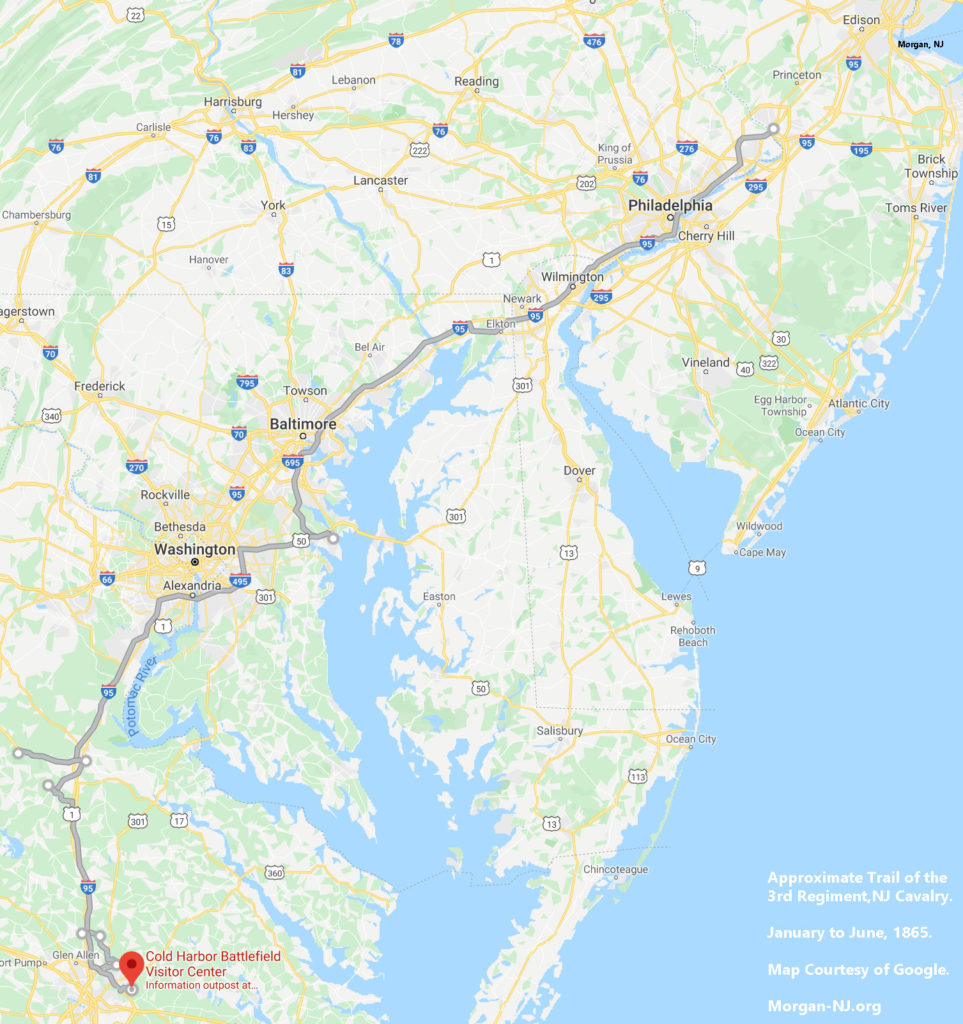
The above map shows, using a technology unthinkable in Dr. Morgan’s day, the movements of the 3rd Regiment, New Jersey Cavalry, during the majority of the time Dr. Morgan was part of it. The exact routes marched from Trenton to Virginia will likely never be known; this map shows the route between locations using the current day US interstate highway system. There are, however, maps that show the detailed route the 3rd Regiment followed while it was part of the 9th (IX) Army Corps, Army of the Potomac.
Below is the chronology of the activities of the 3rd Regiment, New Jersey Cavalry referenced in the above map. This information is provided by the US National Park Service and a number of the locations in the list have links to National Park Service sites containing additional information about the location’s battle.
Overview
- January 26 – March 24, 1864 – Organized at Camp Bayard, Trenton, N. J., and mustered in by Company
- April 5 – 7 – March to Annapolis, Md
- April 29 – May 5 – Guard Orange & Alexandria Railroad
- to May 1864 – Attached to Cavalry, 9th Army Corps, Army of the Potomac
- to June 1865 – 1st Brigade, 3rd Division, Cavalry Corps, Army of the Potomac and Middle Military Division
- to August 1865 – Defenses of Washington, D. C.,
Services
- May 3 – June 12, 1864 – Campaign from the Rapidan to the James.
- May 5 – 7 – Wilderness
- May 5 – Near Germania Ford
- May 6 – Picket on the Rapidan
- May 7 – Guard pontoons
- May 8 – 9 – Expedition to Fredericksburg
- May 9 – 12 – Spotsylvania
- May 12 – 21 – Spotsylvania Court House
- May 19 – United States Ford
- May 23 – 26 – North Anna River
- May 26 – 28 – On line of the Pamunkey
- May 28 – 31 – Totopotomoy
- May 31 – Mechump’s Creek
- June 1 – Ashland Station
- June 1 – 12 – Cold Harbor
- June 2 – Totopotomoy, Gaines’ Mill, Salem Church and Hawes’ Shop
- June 3 – Hawes’ Shop
- June 11 – Bethesda Church
- June 13 – White Oak Swamp
- June 15 – Smith’s Store, near St. Mary’s Church
- June 20 – Weldon Railroad
- June 22 – 23 – Jerusalem Plank Road
- June 27 – Milford Station
- till July 16 – Picket duty at City Point
- July 16 – 25 – Duty at Light House Point
- July 25 – Before Petersburg
The End of the Civil War Was Near
Lawrence’s military career appears to have come to a halt after about seven months. Records show that he resigned on July 28, 1864, about 8 months before the war ended on April 9, 1865. Naturally, no one at the time would have known when the war would end. The record simply lists “Disability” but, here again, no record of the type of disability or the cause has been located.
After Dr. Morgan’s departure, the regiment continued on ultimately being present at Appomattox Courthouse on April 9, 1865, for the surrender of General Robert E. Lee and his army to the Commanding General of the United States, Ulysses S. Grant.
It is interesting to note that Lawrence’s older brother, James Rutus Morgan, an alleged Confederate sympathizer, would later name one of his sons “Robert E. Lee Morgan” – presumably for the famous Confederate general. Nearly 70 years later, a few generations of Morganites would delight at a local restaurant/bar/inn on the western bank of the jetty and channel of Cheesequake Creek presumably named for that Mr. Morgan, or his namesake, the Robert E. Lee Inn.
After the War, I went back to New York Jersey
Subsequent to his time in the war, Dr. Lawrence O. Morgan, appears to have come home to South Amboy (Morgan, now a political sub-division of the Borough of Sayreville, was part of South Amboy until Sayreville was incorporated in 1876). At some point he moved into the main part of South Amboy, we think somewhere near Bordentown Avenue and Broadway. He is mentioned in a number of places in various on-line historical references.
One of these references, the 1882 book, “History of Union and Middlesex Counties, New Jersey” discusses professionals located in South Amboy. It not only mentions Lawrence but it also mentions his slightly older brother, Charles Morgan, as “The Pioneer Lawyer at South Amboy…”
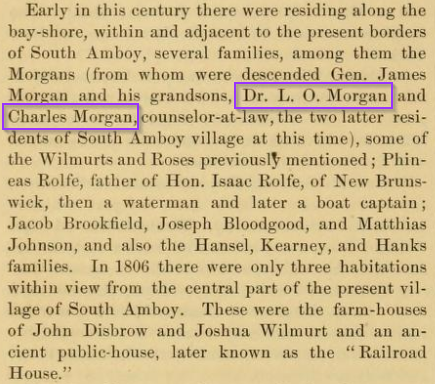
The two brothers are actually listed multiple times!
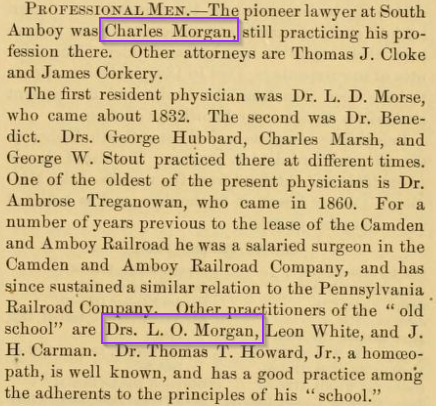
Here Dr. Morgan is shown as a druggist.
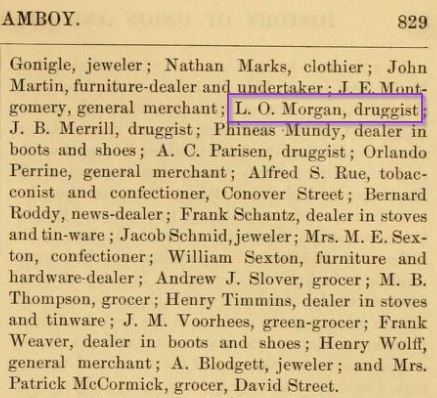
While Lawrence may have left the war early, it seems that the war never left him. His name shows up as one of the March 11, 1878 founders of the Commodore Conover Post No. 2 of an organization named the Grand Army of the Republic (GAR) – not to be confused with the Star Wars Grand Army of the Republic.
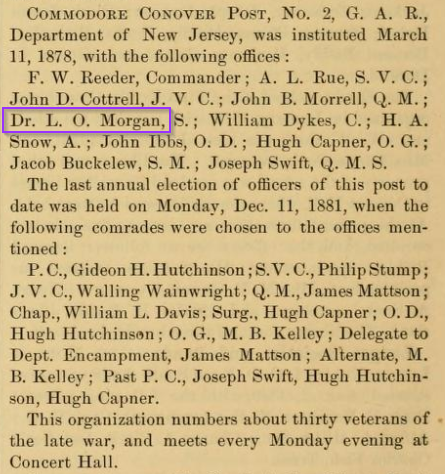
The GAR was an early equivalent to today’s American Legion or Veterans of Foreign Wars (VFW), i.e., an organization created by veterans for comradery and to help promote the interests of veterans. Whereas the VFW was founded by veterans of the Spanish-American War and the Philippine Insurrection, and the American Legion was founded by veterans of World War I, the GAR was founded before both of them (April 6, 1866) by veterans of the Civil War – specifically veterans of the Union Army, Union Navy, Union Marines, and the U.S. Revenue Cutter Service.
You can thank the first GAR Commander-in-Chief, General John A. Logan, for the establishment of today’s Memorial Day dating back to 1868.
Commodore Thomas Anderson Conover, for whom the GAR chapter was named and planned to be the subject of an article on this web site sometime in the (let’s hope) near future, had a very long history with the United States Navy, starting from the War of 1812 through to the African Squadron. From September 1849 until January 1851, Thomas Conover was the commander of the most famous ship in the United States Navy, the U.S.S Constitution. Commodore Conover retired in 1862 and died suddenly in 1864. He is buried in the crypt under Christ Church on Main Street in South Amboy.
The 1880 US Census shows Lawrence Morgan (~age 42) as being married to Anna T Morgan (age 26) as of the June 11 1880 census date. That would have her as having been born about 1854 and them being about 16 years apart in age. No records have been found yet regarding any other information about Anna’s background.
Records show that Dr. Morgan died on 27 Feb 1890 in South Amboy at age 51. Here is the text of his last will and testament:
In the name of God, Amen.
I, Lawrence O. Morgan, of the Borough of South Amboy, in the County of Middlesex, and State of New Jersey, being of sound mind, memory and understanding, do make and publish this my last will and testament in the manner following, that is to say:First, I direct all my just debts and any funeral expenses to be paid, as soon as may be reasonable after my decease.
Second, I give devise and bequeath all my property, real and personal, to my wife Anna T. Morgan.
Third. In making the above devise, it is my will and intention that my said wife Anna T. Morgan shall have, hold, receive, use, enjoy and dispose of the whole, or so much of my estate as she may desire, either for her comfort or happiness, and in case any part thereof may remain unused, unenjoyed or undisposed of at the time of the decease of my said wife, then it is my wish that my said wife shall make such provision, by will or otherwise, that the part so remaining of my estate so received by her, shall be and belong to my sister-in-law Emma Dayton.
Fourth. I constitute and appoint Harry C. Perrine, Executor of this my last will and testament.
In testimony whereof, I have hereunto subscribed my name and set my seal, this twenty sixth day of October, in the year of our Lord one thousand and eight hundred and eighty nine.
Lawrence O. MorganSigned, sealed, published and declared by the said Lawrence O. Morgan the testator to be his last will and testament, in the presence of each other, have hereunto subscribed our names as witnesses.
Rues (?) W. Dayton
Henry Annacoasmuth
Lawrence O. Morgan
Two weeks after Dr. Morgan’s death, the following document was recorded in the “New Jersey, Wills and Probate Records”:
Know all Men by these Presents, That we Anna T. Morgan and Mary E. Dayton of Borough of South Amboy Middlesex County New Jersey and Emma A Dayton also of the said Borough of South Amboy are and firmly bound unto the ORDINARY of the State of New Jersey, in the sum of Twenty four hundred dollars, lawful money of the United States, to be paid to the said ORDINARY or his successors in office; to which payment well and truly to be made, we do bind ourselves our and each of our heirs, executors and administrators, jointly and severally, firmly by these presents. Seated with our seals, and dated the Twelfth day of May I the year of our Lord, one thousand eight hundred and ninety-one.
THE CONDITION IS, That if the above bound Anna T. Morgan
Administrat six with the will annexed of Lawrence O. Morgan late of The Township of South Amboy, Middlesex County deceased, do make and exhibit into the Surrogate’s office of the County of Middlesex, a true and perfect inventory of all and singular the goods and chattels, rights and credits of said Lawrence O. Morgan deceased, which shall come to his knowledge or possession, or to the possession of any other person or persons for his use; and do further make a just and true account of his administration within twelve calendar months from the date hereof; and in all respects faithfully execute the trust imposed, according to the will of said deceased, and the laws of the State of New Jersey; then this obligation to be void and of none effect, or else to remain in full force and virtue.
Lawrence O. Morgan, M.D. was interred in the family cemetery on what is now the only remaining portion of the once vast Morgan Estate between his great-grandmother, Margaret Roetus Evertson Morgan, and his sister-in-law, Sophronia Weston Morgan.
The fate and final resting place of Lawrence’s wife, Anna, has not been determined at this time.
Originally posted on March 25, 2020. Updated on March 29, 2020.